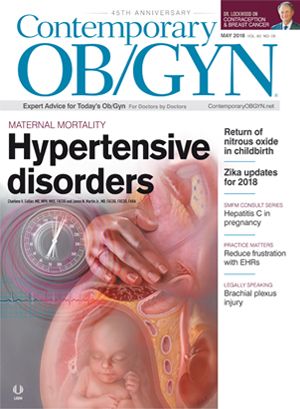Shoulder dystocia and brachial plexus injury
In 2012, a Virginia woman began receiving prenatal care for her seventh pregnancy, during which she was diagnosed with Type II diabetes and obesity. During the delivery, shoulder dystocia was encountered. The baby's right arm was noted to be limp and she was diagnosed with a brachial plexus injury. The woman sued those involved with the delivery, claiming that during the course of her care, the history, physical examinations, and tests showed she had an increased risk for encountering shoulder dystocia during a vaginal delivery.
Dawn Collins, JD

In 2012, a Virginia woman began receiving prenatal care for her seventh pregnancy, during which she was diagnosed with Type II diabetes and obesity. Given her history of large infants she was admitted to the hospital at 37 weeks’ gestation for induction of labor. During the delivery, shoulder dystocia was encountered. The baby weighed 9 lb 10 oz at birth and her right arm was noted to be limp. She was diagnosed with a brachial plexus injury which involved C5, C6, C7, and C8 nerve roots and muscles. The injuries were evident from magnetic resonance imaging, which showed at least 2 nerve root avulsions, and by direct visualization by the surgeon who performed an extensive nerve graft to try to restore some function to the baby’s right arm. Although the baby’s right arm function and range of motion has improved, she has not recovered normal function of the injured nerves nor the muscles they innervate.
The woman sued those involved with the delivery, claiming that during the course of her care, the history, physical examinations, and tests showed she had an increased risk for encountering shoulder dystocia during a vaginal delivery. The patient’s experts opined that the obstetrician was required under the standard of care to obtain informed consent from the patient prior to proceeding with a vaginal delivery, which he did not do. It was also the experts’ opinion that as a part of obtaining informed consent, a discussion was required regarding the risk of shoulder dystocia, the risk of injury to the baby’s brachial plexus nerves if shoulder dystocia were encountered, and the option of a cesarean section. The patient’s expert testified that the standard of care required a physician delivering a baby to use no more than gentle traction in the face of a shoulder dystocia, only when the obstetrician believes that a maneuver has released the shoulder. If any resistance during use of gentle traction is encountered, this would indicate that the shoulder dystocia still exists, so traction must immediately cease and new maneuvers be employed to free the shoulder. It was his opinion that the obstetrician deviated from the standard of care by applying more than gentle traction to the fetal head when the shoulder was still impacted and asserting the severe permanent injury to the right brachial plexus resulted from the excessive lateral traction used, and that the injury would not have occurred had a cesarean delivery been performed. The infant’s experts opined that her injury was permanent, regardless of intervention and therapy.
During deposition, the obstetrician testified that he suspected fetal macrosomia, however, he did not discuss his suspicion with the patient. The labor and delivery nurse testified that prior to the delivery, the obstetrician told her he was expecting a large baby, and that they might encounter a shoulder dystocia. He also testified that he applied traction on the fetal head three times: once after McRoberts, once after suprapubic pressure, and once after delivery of the posterior arm. He dictated in his delivery notes, “We had to be careful to avoid excessive traction forces.” He also claimed that shoulder dystocia was an unpredictable and unpreventable obstetrical emergency and that standard obstetric maneuvers were employed. Further, he argued that the injury was caused by the maternal forces of labor before the obstetrician ever touched the fetal head. The patient’s experts responded that this mechanism of maternal forces injuring the brachial plexus nerve is just an unproven hypothesis.
Verdict: The case settled for $950,000.
Analysis: In malpractice cases that involve a brachial plexus injury from a shoulder dystocia encountered during delivery, the claim is always made that the person delivering the infant used excessive traction, as this connects a person to the injury. While the defense often offers the explanation that the brachial plexus became injured upon delivery of the head with the shoulder stuck behind the symphysis, even with no traction on the head, it is not always successful in defending the case. It is imperative that the person delivering the infant stop any traction once the shoulder dystocia is encountered and not apply anymore traction until one or more appropriate maneuvers are performed. This also needs to be documented in the chart in the delivery note at the time of delivery, and many institutions use a check list-based approach to assure that no critical information is left out. This should be done anytime there is an extra maneuver performed to deliver the shoulder, even if injury is not apparent at the time.
Ureter transected during TLH
A 38-year-old Washington woman underwent a total laparoscopic hysterectomy (TLH) in 2011. During the procedure the right ureter was transected without the surgeon being aware of that. The patient continued to have pain and eventually collapsed. She was airlifted to another hospital in septic shock where she underwent emergency life-saving surgery. She suffered septic shock, near complete loss of function of the left kidney, bilateral adrenal gland hemorrhages, chronic lower extremity pain, cognitive impairment secondary to shock, situational depression and anxiety.
The verdict: A lawsuit was filed against those involved with the operation. After it was learned that the gynecologist did not have privileges at the hospital to perform a TLH, the patient reached a $3 million settlement with the hospital. Just prior to trial, a settlement with the gynecologist and his practice was reached for $1 million and $150,000 from another defendant for a total recovery of $4.15 million.
Question of bowel perforation during hysterectomy
In 2013, a day after a Missouri woman underwent a hysterectomy, she felt ill and presented to the emergency room. She was diagnosed with a pulmonary embolism and treated with anticoagulants. Her problems persisted and over the next 17 days some computed tomography (CT) scans showed fluid in her abdomen and she developed a vaginal fistula. An exploratory laparotomy eventually was required, which revealed a bowel perforation.
The patient sued the surgeon who had performed the hysterectomy alleging that he had perforated her bowel during the procedure. She also sued the hospital where the procedure had taken place. She contended that CT scans showing fluid buildup and her early symptoms after surgery were consistent with a bowel perforation which ultimately caused leakage into the peritoneal cavity and eventually a fistula in the vagina. Her expert pathologist testified that the findings under the microscope could only exist if a bowel perforation had been there a significant period of time before the fistula developed. While she agreed that continuous leakage from the bowel for 17 days would have likely resulted in her death, she presented experts who argued that her injury was not a “free perforation” but had been contained by her body, preventing the spread of the infection.
The case against the hospital was resolved before trial. The matter proceeded against the surgeon only. He maintained that the perforation didn’t happen during the hysterectomy but developed in the days just before the perforation was discovered. The defense argued that a collection of infected fluid at the vaginal cuff over time eroded into the bowel, creating an entryway for stool to pass into the vagina. The defense experts testified that it would have been impossible for the patient to survive if she had an untreated bowel perforation for 17 days. The jury found in favor of the gynecologist.
The verdict: The jury found in favor of the gynecologist.
Hypoxic brain damage after failure to monitor FHR alleged
A Texas woman delivered a baby in 2012. During the oxytocin-augmented labor, the fetal heart rate (FHR) tracing was not recording well on the monitor strip. At delivery the infant had a tight nuchal cord and at birth there were no signs of life. The child was successfully resuscitated but was found to have sustained severe brain damage as a result of profound fetal hypoxia and will require 24-hour nursing and supportive care for life.
The patient sued those involved with her delivery and alleged that losing the FHR tracing was below the standard of care and resulted in the caregivers being unaware of the increasing condition of fetal intolerance to labor, leading to the brain damage. They claimed the nuchal cord was cutting off the oxygen supply to the fetal brain, which would have been seen on the FHR monitor strip and earlier intervention would have prevented the injury.
The defense argued that the nurses continuously monitored by listening to sounds coming out of the bedside monitor even though no recording of the FHR was occurring on the central monitors or FHR monitor strip. They contended that the nuchal cord was an unforeseeable medical emergency and that nothing different could have been done to change the outcome.
The verdict After a week of trial, the parties reached a settlement for an undisclosed amount.
S1E4: Dr. Kristina Adams-Waldorf: Pandemics, pathogens and perseverance
July 16th 2020This episode of Pap Talk by Contemporary OB/GYN features an interview with Dr. Kristina Adams-Waldorf, Professor in the Department of Obstetrics and Gynecology and Adjunct Professor in Global Health at the University of Washington (UW) School of Medicine in Seattle.
Listen
Study shows a healthy prenatal diet could be upstream obesity prevention strategy
December 26th 2024"Our findings support the recommendation of a healthy diet based on the current guidelines (as measured by the HEI) during pregnancy, since it may reduce patterns of infant growth outside reference ranges."
Read More
Early pregnancy cannabis use high in states with recreational legalization
November 11th 2024A population-based time-series analysis California before, during and after legalization show a rising trend in women using cannabis while pregnancy especially when the state has legalized the drug.
Read More

